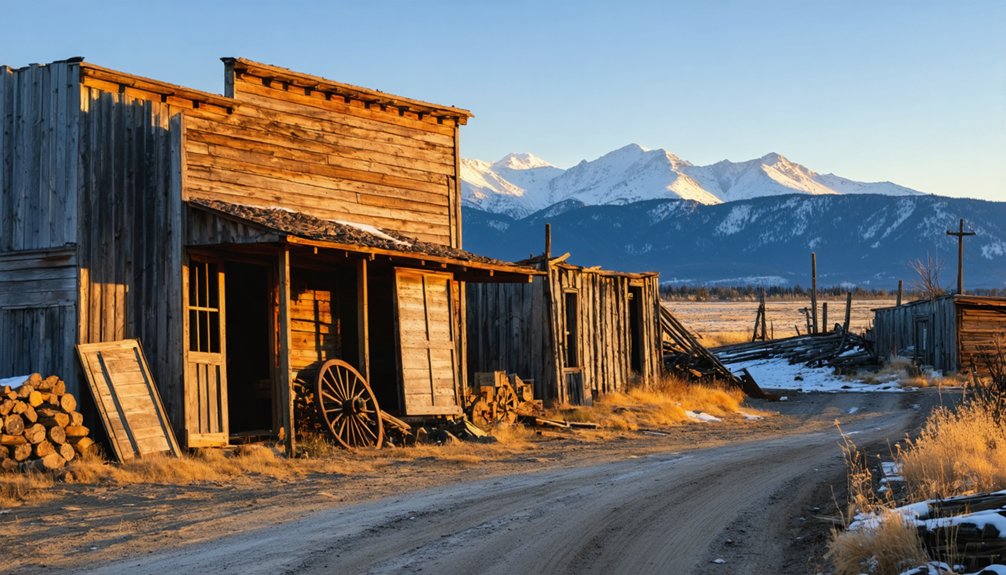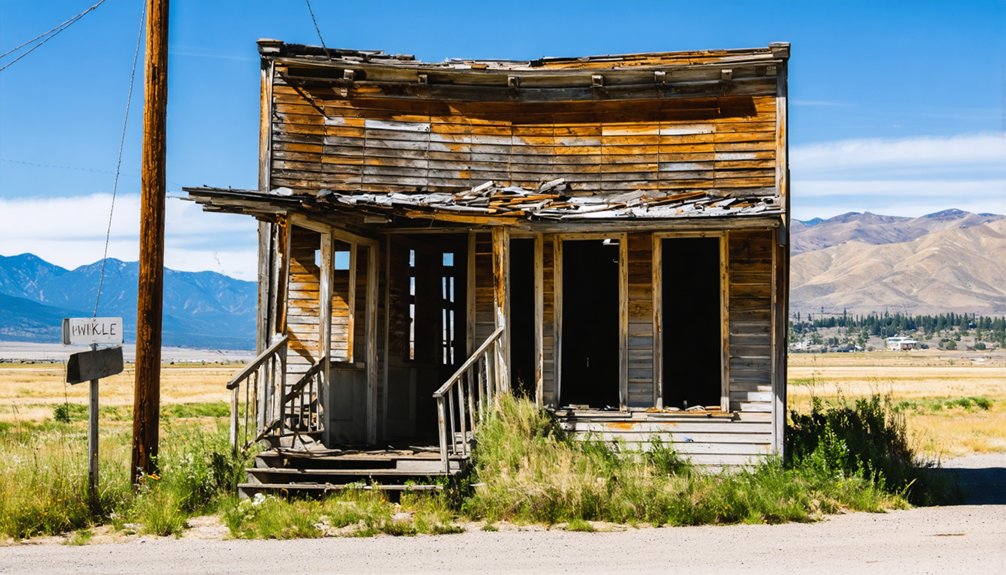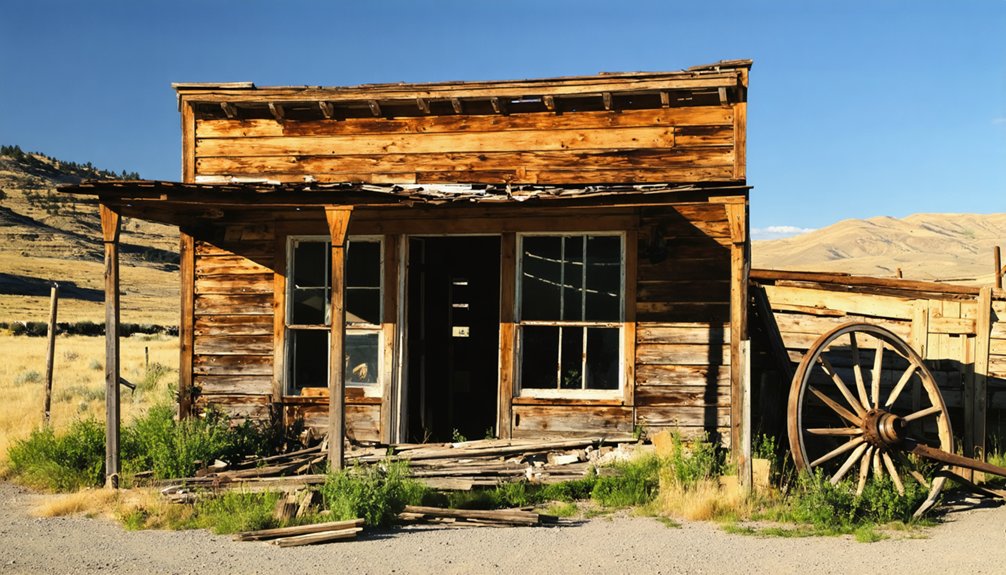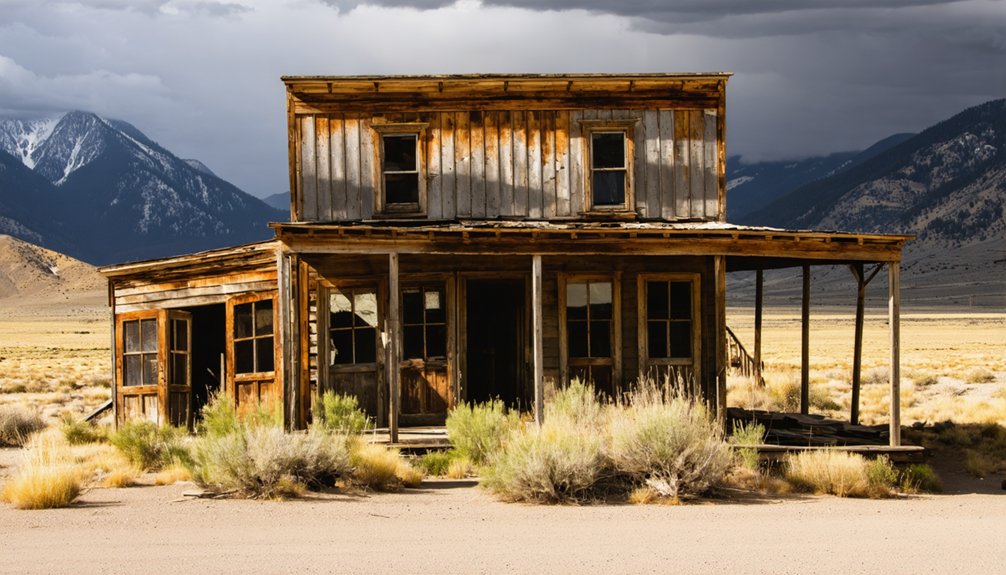You’ll find Mount Idaho nestled in Idaho County, where it once thrived as an essential mining-era hub and county seat from 1875 to 1902. Founded by Loyal P. Brown in 1862, the town served as a significant waypoint between Lewiston and the Florence mining district, with Moses Milner’s toll road connecting regional commerce. During the 1877 Nez Perce War, it became a military staging area and hospital site. The town’s remnants tell a deeper story of Idaho’s frontier legacy.
Key Takeaways
- Mount Idaho, established in 1862 by Loyal P. Brown, served as Idaho County’s seat from 1875 to 1902 before declining into a ghost town.
- The town flourished as a vital waypoint between Lewiston and Florence mining districts during Idaho’s gold and silver rushes.
- Historical remnants include the town cemetery and original building foundations, providing evidence of its frontier-era significance.
- Mount Idaho’s decline began when nearby Grangeville became the new county seat and railroad hub in the early 1900s.
- The ghost town played a strategic role during the 1877 Nez Perce War, serving as a military staging area and hospital.
The Birth of a Mining Era Hub
While northern Idaho’s first mining rush centered on Pierce’s 1860 gold discovery, it was the rich silver and lead deposits found near Kellogg in 1884 that truly transformed Mount Idaho into a thriving hub.
You’ll find that mining innovations along the South Fork of the Coeur d’Alene River sparked remarkable economic expansion throughout the region. The district would go on to produce an astounding 1.18 billion ounces of silver. As prospectors shifted their focus from gold to base metals like zinc and lead, Mount Idaho’s strategic location made it an essential supply center and access point for the booming operations. Chinese miners became a significant part of the workforce, taking on challenging deposits in difficult terrain.
The town’s significance grew further when stagecoach lines connected it to Grangeville in 1899, perfectly timed with the Buffalo Hump quartz discoveries.
Multiple stage stations dotted the route to Lewiston, enabling steady flows of miners, equipment, and ore that fueled the area’s prosperity.
Early Settlers and Town Founders
You’ll find Loyal P. Brown‘s pioneer vision for Mount Idaho took shape in 1862 when he acquired the land and established what would become a significant frontier town.
Before Brown’s arrival, Moses Milner had developed a strategic 45-mile toll road through the region, which he later sold to Brown after a mountain lion attack left him disabled.
The establishment occurred during Idaho’s mining boom era, when the territory was producing significant amounts of gold for the United States.
Brown’s subsequent construction of a prominent hotel, combined with his acquisition of Milner’s road, positioned Mount Idaho as a vital waypoint between Lewiston and the Florence mining district.
The town grew to establish itself as the county seat from 1875 to 1902, serving as a center of government and commerce for Idaho County.
Loyal Brown’s Pioneer Vision
Born in Stratford, New Hampshire in 1829, Loyal Parson Brown would become the visionary founder of Mount Idaho after an adventurous journey that took him from Boston’s mercantile trade to California’s gold fields.
Brown’s pioneering spirit led him to the Camas Prairie in 1862, where he recognized the strategic potential of Mose Milner’s waystation. You can trace his community values through his swift action to establish Mount Idaho as a miners’ supply hub.
He purchased the station for two gray mares, then expanded his ventures to include a store, blacksmith shop, and post office. His stance against saloons shaped the town’s character, while his business acumen transformed the settlement into Idaho County’s seat. His generosity during conflict was evident when he turned his hotel into a hospital to treat wounded soldiers from White Bird Canyon.
Under his leadership, Mount Idaho flourished with mills, shops, and the territory’s first Masonic lodge. During the Nez Perce War of 1877, Brown demonstrated his dedication to community safety by supervising the construction of a protective stockade fort.
Milner’s Strategic Road Development
During the early 1860s, Moses Milner emerged as a significant figure in Mount Idaho’s development through his construction of a strategic 45-mile toll road. His innovations transformed the remote wilderness into an essential transportation hub, connecting lucrative mining districts and establishing necessary supply routes. The area saw rapid growth as pioneer towns flourished throughout the region, mirroring the success of other mining settlements.
You’ll find that Milner’s entrepreneurial vision extended beyond the toll road. He partnered with Francis to cut an important pack trail to Florence mining camp in 1862 and erected a way station that became central to regional commerce. The way station served as a crucial stop for miners heading to Elk City mining camp.
The toll revenue from travelers and freight helped fuel the area’s economic growth until fate intervened – a fierce battle with a mountain lion left Milner permanently disabled, forcing him to sell his interests to Loyal P. Brown.
Despite this setback, Milner’s infrastructure legacy shaped Mount Idaho’s early success as a commercial center.
Strategic Location and Development
Strategically positioned along the historic trail between Lewiston and the Florence mining district, Mount Idaho emerged as an important outfitting point in Idaho County during the 1860s.
The town’s strategic planning capitalized on its location, serving as the only major supply hub in a 120-mile stretch. You’ll find it nestled in the foothills, three miles from where Charity Grange later built their hall. The arid climate of the region has helped preserve old structures that still stand today.
The town’s economic sustainability stemmed from its essential role in supporting the region’s mining operations. With two general stores established by the early 1870s, Mount Idaho became a significant stopover for thousands heading to the gold fields. By 1875, the area had developed into a crucial center with seventeen mining districts operating in the region.
Life During the Nez Perce War
The summer of 1877 thrust Mount Idaho into the heart of the Nez Perce War, as the town became an essential military staging area and refuge following the U.S. Army’s devastating defeat at White Bird Canyon.
Mount Idaho transformed into a vital military outpost after U.S. forces suffered a crushing defeat in the 1877 Nez Perce War.
You’ll find that Mount Idaho served as a critical fallback point for retreating soldiers and a base for coordinating military operations against skilled Nez Perce resistance.
During this tumultuous period, you’d have witnessed U.S. forces regrouping at Mount Idaho while Nez Perce war chiefs Like Looking Glass and White Bird led their people – including 450 women and children – through the region.
The Nez Perce’s superior knowledge of the terrain and effective military tactics resulted in significant U.S. casualties, with 34 soldiers killed near White Bird Canyon.
The military engagements around Mount Idaho marked the beginning of a tragic displacement of Nez Perce people from their ancestral lands.
Commerce and Transportation Routes

Mount Idaho’s strategic location made it a crucial hub where you’d find traders converging at the intersection of major regional routes connecting to Lewiston and Salmon River communities.
You could spot stagecoaches regularly arriving at Mount Idaho’s stations as they traveled along established routes that linked the settlement to other mining communities and agricultural centers.
If you were traveling through the area in the 1860s and 1870s, you’d have paid tolls to use the Lewiston-Mountain House Wagon Road, which served as one of the region’s primary transportation arteries.
Strategic Trade Location
Situated between the bustling gold mines of Florence and the essential river port of Lewiston, Idaho County’s first county seat emerged as a significant trade hub bridging a 120-mile commercial gap.
Mount Idaho’s economic significance grew as it developed important trade networks through a web of wagon roads and pack trails. You’ll find the 75-mile Lewiston-Mount Idaho Wagon Road served as the backbone of regional commerce, while the strategic 1889 route to Little Salmon Meadows opened critical east-west connections.
The town’s position made it indispensable for moving mining supplies, foodstuffs, and heavy freight across challenging terrain. As a distribution point for both commercial and military goods, Mount Idaho integrated seamlessly with territory-wide transportation corridors, including extensions toward Payette Lake and the Salmon River.
Toll Road Development
Pioneering entrepreneur Mose Milner established an essential 45-mile toll road near Mount Idaho in 1860, creating one of the region’s earliest controlled-access routes.
After a mountain lion attack left Milner injured, Loyal P. Brown took ownership of the operation, overseeing its development into a significant transportation artery.
The toll road’s advantages included reliable passage for pack trains, stagecoaches, and freight shipments between Lewiston and Florence, transforming Mount Idaho into a bustling trade hub.
You’d find merchants and miners regularly traversing this route, despite the toll road challenges of added travel costs.
By 1873, the integration of stagecoach service enhanced the road’s utility, connecting mining camps to essential supply chains.
This infrastructure played a pivotal role in the region’s economic growth, supporting Idaho’s rugged mining frontier.
Stagecoach Routes Established
By 1873, stagecoach service connected Mount Idaho with Lewiston, establishing one of the region’s earliest transportation networks.
You’d find stations positioned every twelve to fifteen miles along the route, with larger home stations spaced fifty to sixty miles apart. These stagecoach connections proved essential for accessing the area’s lucrative gold mining districts.
The transportation evolution brought both challenges and opportunities to Mount Idaho. Drivers navigated rugged terrain and harsh weather while carrying valuable cargo and passengers at roughly twenty cents per mile.
The Utah, Idaho, and Oregon Stage Company expanded operations throughout the region, spurring economic growth and settlement patterns. When necessary, they’d establish alternative routes, like the Mount Idaho to Little Salmon Meadows Wagon Road, ensuring reliable access to remote areas.
Community Buildings and Infrastructure

The ghostly remains of Mount Idaho’s original buildings stand as a tribute to its frontier legacy, with numerous structures still present despite varying states of decay.
You’ll find an array of community amenities that once served the town’s pioneers, including commercial storefronts, hotels, and saloons strategically placed along transport routes. The town’s historical significance is evident in its infrastructure, featuring one of the region’s first toll roads.
The cemetery remains intact, offering a window into the past, while civic structures and public buildings reflect the town’s role as a former county seat.
You can still trace the town’s layout through its remaining residential homes, business districts, and essential services that supported both miners and settlers during Mount Idaho’s heyday.
Peak Years as County Seat
During Mount Idaho’s tenure as county seat from 1875 to 1902, you’d find the territorial legislature‘s offices and courts handling an expanding population that grew from 3,000 to over 9,000 residents.
You’ll recognize the town’s pivotal role in the region’s development through its hosting of Idaho’s first territorial convention in 1861 and its position as the administrative hub for the burgeoning mining communities.
As the primary government center, Mount Idaho coordinated mining claims, settled disputes, and managed the complex affairs of a rapidly growing county during the height of Central Idaho’s mineral rushes.
Government Operations and Growth
Serving as Idaho County’s seat of government from 1875 to 1902, Mount Idaho established itself as an essential administrative hub that managed seventeen mining districts across the region.
You’d find vital government services housed in the county courthouse, while a post office operated until 1922. The town’s early political significance emerged when it hosted the Idaho Territory’s first Republican convention in 1863.
During its peak, Mount Idaho’s administrative reach extended across a diverse landscape of mining and farming communities.
The establishment of a Masonic Lodge and the conversion of a hotel into a wartime hospital during the 1877 Nez Perce War demonstrated the town’s growing civic organization.
However, this administrative prominence wouldn’t last – the transfer of the county seat to Grangeville in 1902 marked the beginning of Mount Idaho’s decline.
Political Hub Development
After replacing Warren as Idaho County’s seat in 1875, Mount Idaho quickly established itself as a pivotal administrative center managing the region’s rapid territorial expansion.
You’d find the town wielding significant political influence through its strategic position and growing infrastructure, connecting the rugged mining territories to civilization via stagecoach routes to Lewiston.
- The town hosted Idaho’s first Masonic lodge, cementing its status as a center of territorial civilization
- It served as the hub for political conventions and critical governance practices during the late 19th century
- Mount Idaho’s administrative reach extended across vast territories drained by the Salmon and Clearwater rivers
During its peak years, the town’s population of 400 supported extensive business operations, making it the heart of regional politics and commerce throughout the 1880s.
Leadership During Mining Era
The mining boom of Mount Idaho brought forth influential leaders who shaped the town’s destiny throughout its peak years as county seat.
You’ll find L.P. Brown at the forefront of leadership dynamics, establishing the town’s foundation through his sawmill operations and hotel ownership. The economic contributions of merchants like Wallace Scott and major firms such as Grostein & Binnard defined the commercial landscape.
“Judge” James W. Poe emerged from his mining roots to become a respected legal authority, representing the town’s evolution from mining camp to structured settlement. These leaders managed everything from essential lumber production to merchandise operations, creating a network of services that supported both mining and agricultural interests.
Brown’s hotel served as the political nucleus, where leaders gathered to shape Mount Idaho’s future.
The Shift to Grangeville
While Mount Idaho thrived as Idaho County’s seat in 1875, its dominance wouldn’t last against Grangeville‘s strategic advantages just three miles away.
The economic change began when the railroad bypassed Mount Idaho in favor of Grangeville’s more accessible location. You’ll find this shift marked the beginning of a dramatic population decline as businesses and residents sought better opportunities in the emerging rail hub.
- Grangeville’s agricultural lands proved more attractive as mining activity decreased
- The railroad’s arrival transformed Grangeville into a modern transportation center
- Mount Idaho’s role as a supply point became obsolete as commerce shifted
Remnants and Archaeological Significance

Today’s visitors to Mount Idaho can explore tangible links to Idaho County’s mining and pioneer heritage through several significant remnants.
You’ll find L.P. Brown’s 1859 hotel, which served as a hospital during the Nez Perce War, standing as one of the area’s most culturally significant structures.
Archaeological findings reveal a complex network of roads, trails, and mining-related infrastructure that once supported the bustling frontier town.
The site’s historical artifacts paint a vivid picture of 19th-century settlement patterns and cultural exchange.
A 45-mile toll road, opened by 1860, connected the town to crucial trade routes, while the cemetery holds remains of those who shaped the region’s history.
Unlike other restored ghost towns, Mount Idaho’s unmanaged state offers an authentic glimpse into the American West’s gold rush era.
Historical Impact on Idaho County
Serving as Idaho County’s governmental nucleus from 1875 to 1902, Mount Idaho emerged as a crucial administrative center that shaped the region’s early development.
Mount Idaho’s quarter-century tenure as county seat established foundational governance that influenced Idaho’s territorial expansion and administrative growth.
The town’s historical significance extended beyond its role as county seat, impacting the territory’s economic and social landscape during the late 19th century.
- You’ll find traces of its mining economy influence as the sole outfitting stop on the 120-mile stretch between Florence and Lewiston.
- During the Nez Perce War of 1877, the town’s hotel transformed into a hospital, cementing its place in the region’s cultural memory.
- The development of toll roads and stagecoach routes through Mount Idaho created essential transportation networks that connected remote mining camps to territorial centers.
These contributions fundamentally shaped Idaho County’s infrastructure, commerce, and settlement patterns before the town’s eventual decline.
Frequently Asked Questions
What Was the Highest Recorded Population of Mount Idaho During Its Peak?
You won’t find exact population statistics for Mount Idaho’s peak, as historical demographics weren’t well documented. While it served as county seat (1875-1902), records don’t reveal specific population numbers.
Are There Any Surviving Photographs of Mount Idaho From Its Heyday?
While you might expect historic images of this fascinating ghost town to exist somewhere, there’s no conclusive evidence of surviving photographs from Mount Idaho’s heyday in currently available historical records.
What Happened to the Original Toll Road’s Collection Stations?
You won’t find any documented remains of the toll road’s collection stations today – historical records don’t show their exact locations or what became of these early revenue points along Milner’s route.
Did Mount Idaho Have Its Own Newspaper During Its Active Years?
If you’d been in Mount Idaho around 1900, you’d have read the Mt. Idaho Mail, run by Frank J Parker. Earlier, there was the Mount Idaho Radiator in 1873, but both newspapers were short-lived.
Were There Any Notable Crimes or Lawlessness Incidents in Mount Idaho?
You’ll find few documented crime incidents in the records, except for Charles Wilson’s kidnapping in the 1890s. As a county seat until 1902, law enforcement existed but left minimal evidence of major lawlessness.
References
- https://yellowpinetimes.wordpress.com/2018/08/19/idaho-history-aug-19/
- https://www.thegoldminehotel.com/ghost-towns-and-haunted-places-in-idaho
- https://pinintheatlas.com/travel-blogs/ghost-towns-of-idaho/
- https://yellowpinetimes.wordpress.com/2018/08/12/idaho-history-aug-12/
- https://history.idaho.gov/wp-content/uploads/2018/08/0064.pdf
- https://www.ghosttowns.com/states/id/mountidaho.html
- https://www.youtube.com/watch?v=rTSZSlxTmbs
- https://www.isu.edu/digitalgeologyidaho/n-idaho-mining/
- https://www.goldprospectors.org/News/ArtMID/406/ArticleID/658/Gold-Mining-in-Idaho-Then-Now
- https://history.idaho.gov/wp-content/uploads/2018/08/0009.pdf



